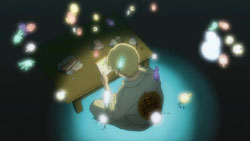 |
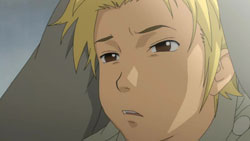 |
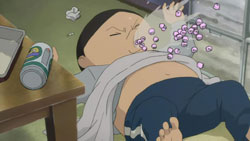 |
 |
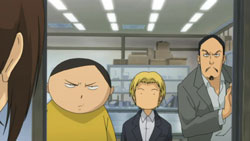 |
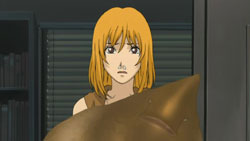 |
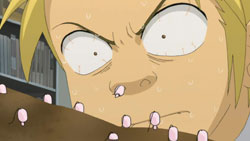 |
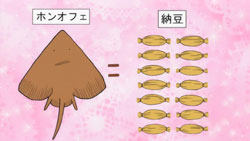 |
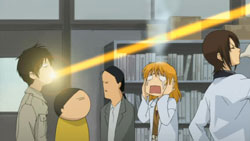 |
 |
 |
 |
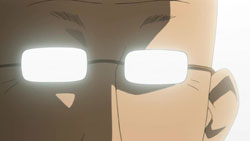 |
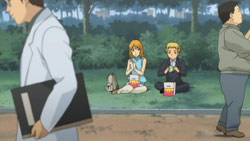 |
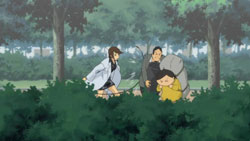 |
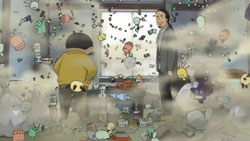 |
 |
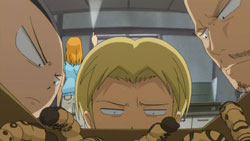 |
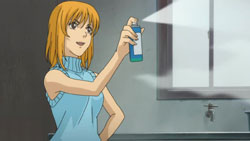 |
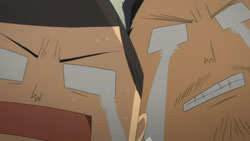 |
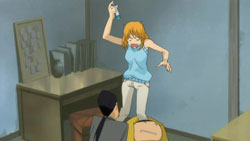 |
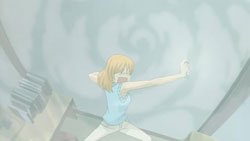 |
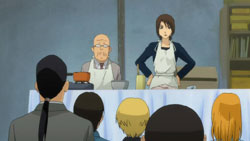 |
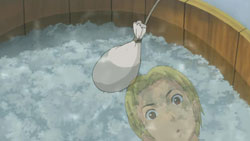 |
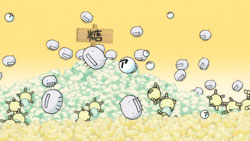 |
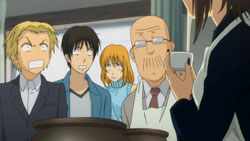 |
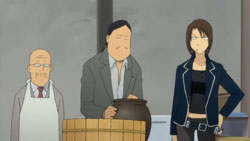 |
 |
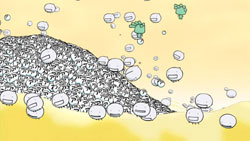 |
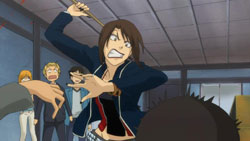 |
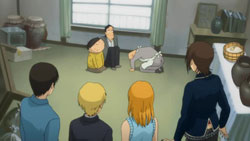 |
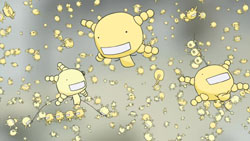 |
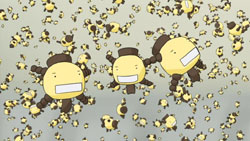 |
It’s a brand new day, and Sawaki wakes up in the shabby dorm room of the sophomore students. Misato urges the other two to join him in going down and seeing the students’ notice board for that day and they depart from the dorms. Sawaki notices that Kei still has not returned; it turns out that he was coerced into helping Haruka with her research the entire night.
The notice board has a sign that calls for Sawaki, Kei, Misato, and Kawahama to visit Professor Itsuki’s lab ASAP, so the three reluctantly make their way. They enter the lab, and Haruka greets them rather crudely (“Two pieces of garbage and Sawaki-kun, you’re here already?”). The professor finally enters, and he talks about wanting to celebrate Sawaki’s admittance to the university. He calls out to a freshman he “found randomly,” Oikawa Hazuki. She makes her way into the room, carrying what appears to be a ray (the one that is a fish). Clearly disgusted with what she is holding, she sets it up on the table and starts to cut its flesh into neat, thin strips (Itsuki bribed her with the promise of giving her one unit if she cleans and butchers the meat).
We learn that what Hazuki is preparing against her will is a Korean delicacy known as hongeohoe, which is pretty much a sashimi of a fermented ray. Sawaki learns to his horror that hongeohoe has an atrocious smell – Itsuki explains that it has four times the odor intensity of the bizarre Inuit cuisine, kiviak, which was introduced back in episode one (kiviak, remember, is a dish consisting of decomposed auks and similar seabirds that achieved fermentation by being stuffed in the body of a dead seal). Needless to say, the hongehoe is not well-received by the students, who clearly feel sick at its putrid odor.
(Note: The buying and selling of hongeohoe is illegal in Japan because of the considerable amount of ammonia it releases; the hongeohoe served this episode, however, is given special jurisdiction as part of college “research”)
Sawaki decides to ask here about what Professor Itsuki’s motivation for microbiology could possibly be; it turns out that he is continuing his research in hopes of advancing the hypothetical science of terraforming. He ends his speech on terraforming, which he insists will require Sawaki’s ability, and has Haruka hand out a financial bill to Misato and Kawahama. Misato and Kawahama looks at the bill in horror to find out that they are entrusted with paying for the repairs of the first floor of the microbiology building.
Sawaki has lunch with Hazuki (while the sophomores and Kei are forced into working with Haruka), and he finds out here that Hazuki is a considerable germaphobe. Still, she accompanies Sawaki into Misato and Kawahama’s dorm. She then enters their room, and *loses* it. She goes on a cleaning spree and starts spraying the room with antibacterial spray. All the spraying, unfortunately, kills the culture of cordyceps sinensis that the sophomores were trying to raise in order to pay off their debt – hilarity ensues (“Why are you such a neat freak anyway? Do you know just how many bacteria are inside your body?!”)
Itsuki, Haruka, and Kei join the fray inside the dorm room – Professor Itsuki enthusiastically announces that the construction plans of the first floor of the microbiology building are complete. Misato and Kawahama are further shocked to learn that their debt is paying not only for the repairs, but also for the construction of an expanded lab on the floor as well. Itsuki pays a deaf ear to their plight, and with Haruka, begins a demonstration on how to brew sake – in this case a simple sake known as どぶろく/doburoku (濁酒). (Note 2: As with hongeohoe, non-commercial and non-licensed brewing of sake is illegal in Japan…unless it is part of university research or instruction, of course! ;))
How to Brew Doburoku Sake, by Professor Itsuki
.
.
A discussion about another recipe, 口噛みの酒/kuchikami no sake (lit. “mouth-chewed sake”) takes place amongst the characters. This particular method requires no aspergillus oryzae and instead relies on you to chew rice/chestnuts/acorns. The saliva saccharifies, or converts the starch in these to sugar which you then…spit…into the water with saccharomyces cerevisiae and cooked grain. Sounds a bit unhygienic, yes, but the saccharomyces cerevisiae will convert the sugar into alcohol so it should be safe to drink several days later. Haruka mistakenly drinks this variant of sake and *hates* how it tastes – she goes on to thrash Misato and Kawahama. Professor Itsuki is moved by the two, rather than repulsed, and apologizes for forcing a massive debt on them. He insists that they assist him in his research and bows down. :O
.
.
This week’s Microbe Theater: Aspergillus oryzae, which should be familiar to viewers by this point (I hope) introduces us to their “family”
.
.
Thoughts: Whew. That was a LOT of content to go through, but it was absolutely hilarious. The comedic value goes up a notch, and we are introduced to a new character, Oikawa Hazuki – an obsessive compulsive neat freak who carries hand sanitizer, antibacterial wipes, and antibacterial spray with her 24/7. Haruka’s sadistic nature blossoms (if you can call it that) as well, as she continues to verbally and physically abuse the undergrads she is supposed to be helping.
The only downside to all of this is that the number of scientific terms mentioned also shoots up, and following the dialogue gets tricky, if not impossible at certain parts of the episode for even the veteran anime fan. I’m quite positive even native Japanese speakers will also be scratching their heads at all the technical terms used (I sure did) if they do not have a background in the scientific realm. It is very informative despite the technicality, and I for one actually learned about the processes involved in brewing sake. Oh, and Sawaki gets a cookie this week for coming up with this quote: “So basically, sake is like a bunch of microbe faeces.” Oh boy.
Next time: The 3-second previews are firmly rooted to the spot. The title is 「あちこち菌祭り!」 (achikochi kin matsuri), so we will either see a cultural festival episode, or just microorganisms celebrating. I won’t mind having both. 😀

Haruka is beginning to scare me a bit. She drew blood in this episode! XD;;
This episode also answers what happens when the microbes get killed. I was wondering what would happen when eventually one of the student or the professor has to sterilize something. Seeing the dying microbes now makes me feel bad every time I put my loop into the Bunsen burner during lab, or use an alcohol hand sanitizer. ;_;
really agree wif u omni..i’m really falling in love wif this anime =P all the cute microscope bacteria but i’m wondering thos scientific things are real or not.. if it’s real than i’m learning more about bio science from this show than from school (assuming i dun sleep in class XD) hehe (^-^)
@ padfoot:
i’m mewmew, actually ^^;
the scientific information in moyashimon are generally very accurate, so no worries there (the only mistake i know of that the manga author made is using an outdated scientific name for a species of bacteria – which is nothing major at all).
Lucky I have some molecular biology background.
Thanks mewmew! If it weren’t for your summaries, I’d be lost!
YEA LOVE THIS SHOW! Great for those taking biology or geogprahy in the exams! a must-watch for comedy lovers XD
One of the few times where I expect the sub will be better than the raw because at least the terms will be written out on screen!
Um, Mikuru Beam?
https://randomc.net/image/Moyashimon/Moyashimon%20-%2003%20-%20Large%2009.jpg
Awesome. Thanks for blogging this.
@ sailor enlil:
i think hyper beam will be more accurate. 😀
this show should be rated “MPA” most paused anime, cuz lord knows i can’t read the tl note’s FAST enough!! show is off the chain!!! wish i had this to watch when i was taking Micro biology.
this show is disturbing
Great review mewmew! Informative and funny! Thanks! 😀
Funny! I’m lovin’ this!
thanks!!
i’m confused about the sake though… you say you throw the onigiri away, but the streptococcus lactis is from the onigiri, isn’t it?
not that i’m going to make sake, but i’m just interested XD
@reg:
im guessing enough streptococcus lactis from the onigiri is collected while it is sunk inside the basin with rice and water, since it is left inside for three days. any more and i would think the onigiri would grow stale/spoiled, hence throwing it away. 🙂
I don’t know if any of you noticed… but…
http://www.clubotaku.org/niji/images/series/mouashimon/anime_coimbra1.jpg
Noticed that you made a typo in the link? YUP, I definitely noticed that hehe